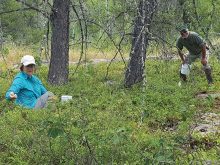Science fiction often portrays giant plants as monsters — think Audrey II from “Little Shop of Horrors,” and the marauding Triffids in “Day of the Triffids.”
But the titanic tomato growing soilless here in the United States Botanic Garden greenhouse for more than a year seems benign enough, but its size and age make it unique.
It doesn’t contain foreign DNA so it’s not a genetically modified organism.
Read Also

Mandatory holiday joy a valid struggle
Christmas may not be that jolly for everyone. Farm family coach Kalynn Spain suggests those struggling with over-the-top joy during the holidays instead aim for “fulfilled” or “content.”
Nor was it created through mutagenesis by exposing it to radiation or chemicals.
Its genes were not edited.
It’s just a tomato, albeit one that has already had its first birthday and is about 36 feet long with vines thicker than your thumb.
“Our gardener set our hydroponic system and I think he has really tailored the nutrients very specifically for tomatoes,” Devis Dotson, public affairs and exhibits specialist for the United States Botanic Garden (USBG) says in a May 27 interview. “To be honest, I think it’s super happy to be getting more tailored nutrients than it ever would outdoors.”

A month earlier, Dotson showed this remarkable plant to members of the North American Agricultural Journalists Association in town for their annual meeting.
USBG is surprised how long this tomato has not only lived, but how it remains so healthy, he said.
It’s part of the USBG’s latest exhibit running until December 2023 called ‘Cultivate: Growing food in a changing world.’
Agriculture takes many forms, including hydroponics, where water mixed with nutrients feed plants indoors without soil, where lights replace the sun and pests can be more easily managed.
“Indoor growing, or controlled-environment agriculture, can produce seasonal crops year round and keep short-lived crops like peppers alive and producing food for years,” reads a sign by the tomato display.
“The tomato plant is usually grown in the tropics as a perennial plant but in other areas it is mostly grown as an annual plant,” says the North Dakota State University’s website. “The plant originated in Chile and now has spread all throughout the world. It is the second most widely grown plant in the world and is the No. 1-grown garden plant.”

And then there’s the age-old question: Is the tomato a fruit or a vegetable?
It’s both, according to Britannic online.
“Tomatoes are fruits that are considered vegetables by nutritionists,” the site says. “Botanically, a fruit is a ripened flower ovary and contains seeds. Tomatoes, plums, zucchinis, and melons are all edible fruits, but things like maple ‘helicopters’ and floating dandelion puffs are fruits too. For some reason, people got hung up on tomatoes, but the ‘fruit or vegetable’ question could also work for any vegetable with seeds.”
This tomato has been flowering and setting fruit for months. Staff pick the ripened tomatoes.
“It’s being pruned as necessary but not necessarily to keep it short,” Dotson says. “It’s already the length of the room and wrapping back the other direction at this point. As growth continues… and if necessary, we’ll wrap it and bring it back the other way again. We’ve got the vertical supports to support it throughout as necessary.”
While tomatoes are self-pollinating the tomato is exposed to outside breezes as greenhouse windows automatically open and close throughout the day, Dotson said.
The downside is the potential introduction of a disease, something staff are watching closely for.
“It’s definitely a daily watch,” Dotson said.

The USBG’s agriculture exhibit shares “the stories of agriculture from the people who grow the food and the important cultural connections food provides to modern techniques and scientific innovations that make agriculture more sustainable and productive,” the USBG said in a news release.
“Visitors can explore the galleries and gardens to learn how inventive ideas in agriculture, both scientific and social, sustain and enrich life and how growing and cooking food connects people with each other and their communities. Agriculture, the science and technique of growing crops and livestock, depends on innovating how we grow plants. Agricultural innovation and knowledge sharing continue today in laboratories, on farms, and at botanic gardens like the USBG.
“Visitors can see dozens of colourful varieties of corn and learn about the wild relatives of modern plants we eat, go hands on to explore the science of agriculture through microscopes and hand lenses, dive into the stories of the many different peoples who have farmed the land through the centuries, and enjoy the smells of the plants that connect several local chefs with their food cultures as they share their stories in their own words.”
















